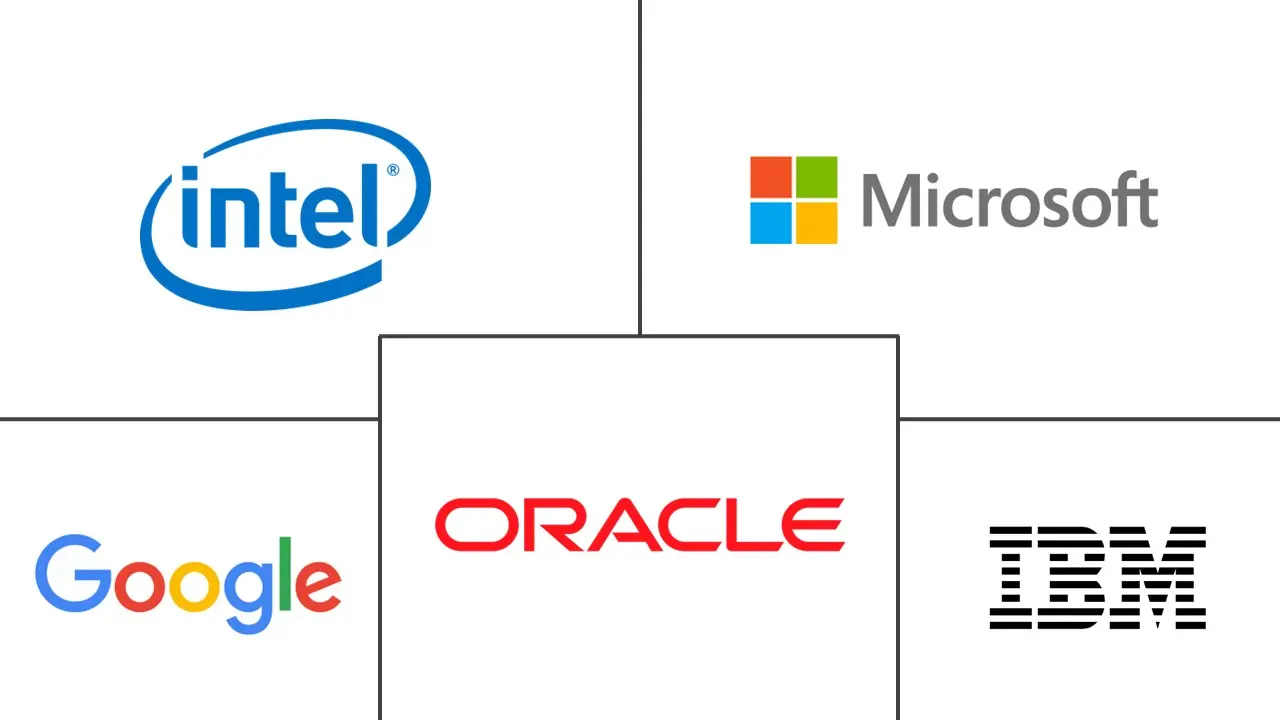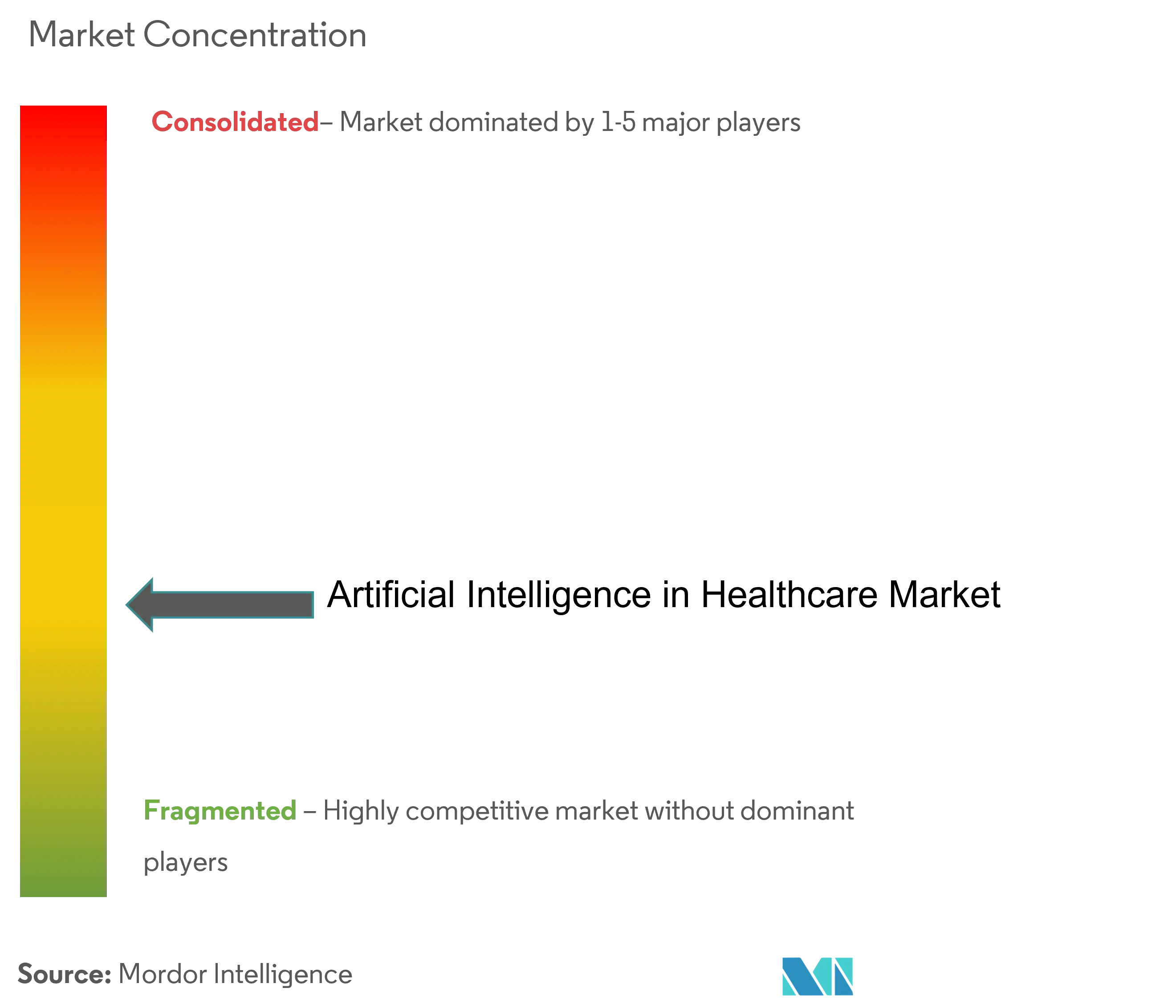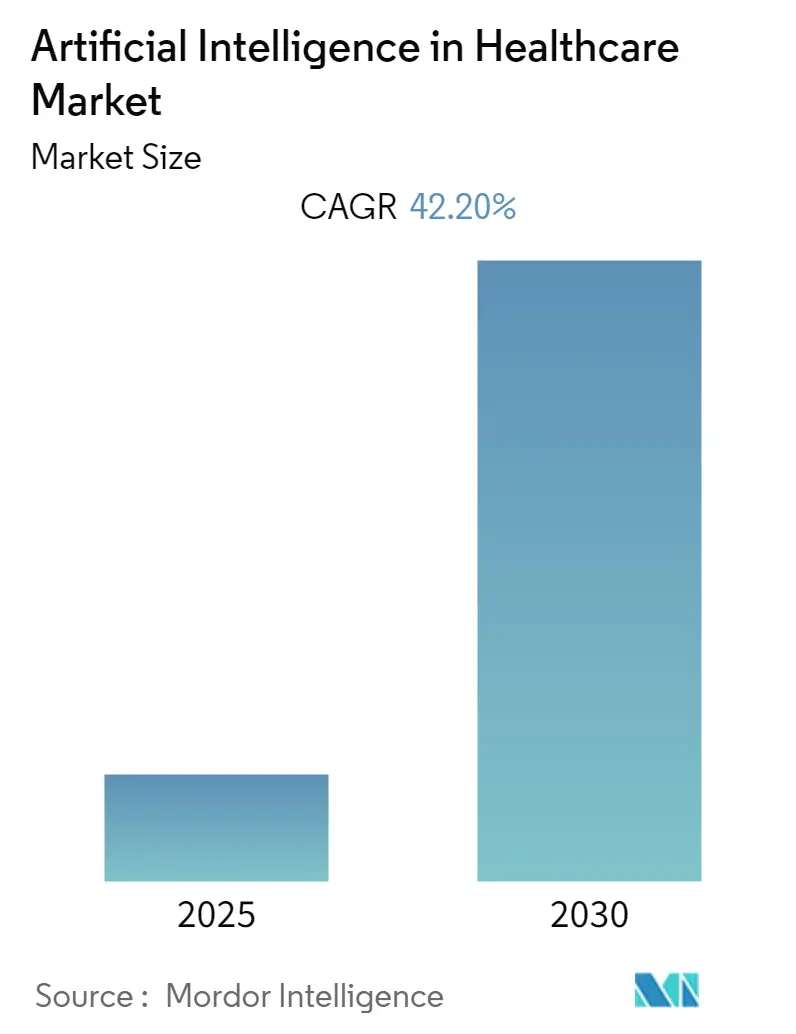
AI in Healthcare Market Analysis
The Artificial Intelligence in Healthcare Market is expected to register a CAGR of 42.2% during the forecast period.
The COVID-19 pandemic increased the demand for artificial intelligence (AI) in healthcare. This is due to the increasing demand for AI-based tools and solutions that can evaluate and diagnose COVID-19. According to a study published by Intelligence Medicine in May 2021, artificial intelligence (AI) has aided in addressing challenges and accelerating progress in mitigating this public health crisis. It has been used in applications ranging from outbreak forecasting to patient management and drug/vaccine research.
AI-based techniques are widely used in four areas: patient tracking and monitoring, screening and diagnosis, characterization and severity evaluation, and prognostic prediction in COVID-19 patients. Additionally, according to the study published in MDPI Diagnostics in November 2022, AI systems are beneficial for complex medical diagnoses that traditional statistical methods cannot manage. Models that auto-regulate, recognize, segment, and classify COVID-19 data are utilized in AI for screening and diagnosing COVID-19. Thus, the pandemic positively influenced the studied market. Currently, the market is predicted to develop further over the forecast period, as demand for AI in healthcare is expected to rise due to the increased prevalence of chronic diseases and the use of AI in their management.
The market is primarily driven by the growing need to reduce healthcare costs, utilization of big data in healthcare, the ability of AI to improve patient outcomes, and the ever increasing importance of AI-assisted robotic surgeries. For instance, according to a study published in the International Journal of Environmental Research and Public Health in January 2021, more than 60% of hospitals globally had incorporated IoT in their facilities. It also stated that "AI applications could generate up to USD 150 billion in yearly savings for United States healthcare by 2026." By 2021, hospitals planned to invest USD 6.6 billion annually in AI-related technologies. Thus, by implementing AI in healthcare, healthcare costs can be reduced, driving demand for AI in healthcare over the projected period.
Additionally, the rising application of big data in healthcare, as well as strategies to bring the big data system into healthcare are expected to support market expansion. In March 2022, the government of Thailand launched a big data portal for healthcare facilities. The National Reform Committee on Public Health recently joined hands with 12 government agencies to improve the quality of healthcare services through the implementation of digital technologies. Similarly, in March 2022, Microsoft launched its Azure Health Data Services. It is a Platform as a Service (PaaS) offering designed exclusively to support protected health information (PHI) in the cloud.
Furthermore, the introduction of an advanced technological products by the market players is expected to propel the growth of the market. In September 2022, AGS Health, a revenue cycle management (RCM) solutions provider, announced the launch of the AGS AI Platform, a connected solution that combines artificial intelligence (AI) and automation with award-winning human-in-the-loop services and professional support to maximize revenue cycle performance.
Additionally, in March 2022, Health Catalyst, Inc. announced the new Healthcare.AI launch. Created to address healthcare business opportunities and challenges across revenue, cost, and quality, Healthcare. AI suite of augmented intelligence (AI) products and services will significantly expand AI's effective use and use-cases in healthcare. In March 2022, NVIDIA Corporation launched Clara Holoscan MGX, a device that is used to accelerate innovation in the medical industry. It uses real-time AI.
Thus, all the above-mentioned factors, such as the growing need to reduce healthcare costs and product launches by the market players, are expected to boost the market over the forecast period. However, reluctance among traditional practitioners to adopt AI-based technologies may restrain the market growth.
AI in Healthcare Market Trends
Medical Imaging & Diagnostics To Hold Significant Share in the Market
In diagnostics, AI enables healthcare providers to make the most appropriate treatment decisions for their patients. AI can be used to identify cancer, triage crucial discoveries in medical imaging, flag acute abnormalities, assist radiologists in prioritizing life-threatening patients, diagnose cardiac arrhythmias, forecast stroke outcomes, and assist with chronic disease management.
The rise in the prevalence of chronic diseases, along with product launches by market players, drives the segment. For instance, the Cancer Facts and Figures 2022, published in January 2022 by the American Cancer Society, predicted approximately 1.9 million new cancer cases in 2022, estimating 186,670 prostate cancer cases, followed by 169,870 cases of lung cancer and 144,490 cases of female breast cancer. The increased prevalence of cancer and the high burden of other chronic diseases are, in turn, increasing the demand for accurate diagnosis and treatment. This is likely to increase the adoption of AI for early diagnosis purposes, ultimately boosting the market growth.
Incorporating AI into imaging devices may improve diagnosis, which is expected to aid market growth during the forecast period. For instance, in December 2021, Roche introduced three artificial intelligence (AI) based, deep learning image analysis Research Use Only (RUO) algorithms developed for breast cancer. Additionally, in April 2022, Arterys, the vendor-neutral AI platform, launched several new modules to its robust Cardio AI clinical application and an additional (eighth) Food and Drug Administration (FDA) AI clearance based on deep learning.
Additionally, various strategies adopted by the market players are expected to propel the segment's growth. For instance, in November 2021, LifeVoxel, based in San Diego, raised USD 5 million in a seed round to improve the data intelligence of its AI diagnostic visualization platform for faster and more accurate prognosis. Healthcare facilities employ the Software-as-a-Service (SaaS) platform for remote diagnostics in various medical specialties, including radiology, cardiology, and orthopedics.
Thus, all the aforementioned factors, such as the growing prevalence of chronic diseases and key strategies adopted by market players, are expected to boost the segment's growth over the forecast period.
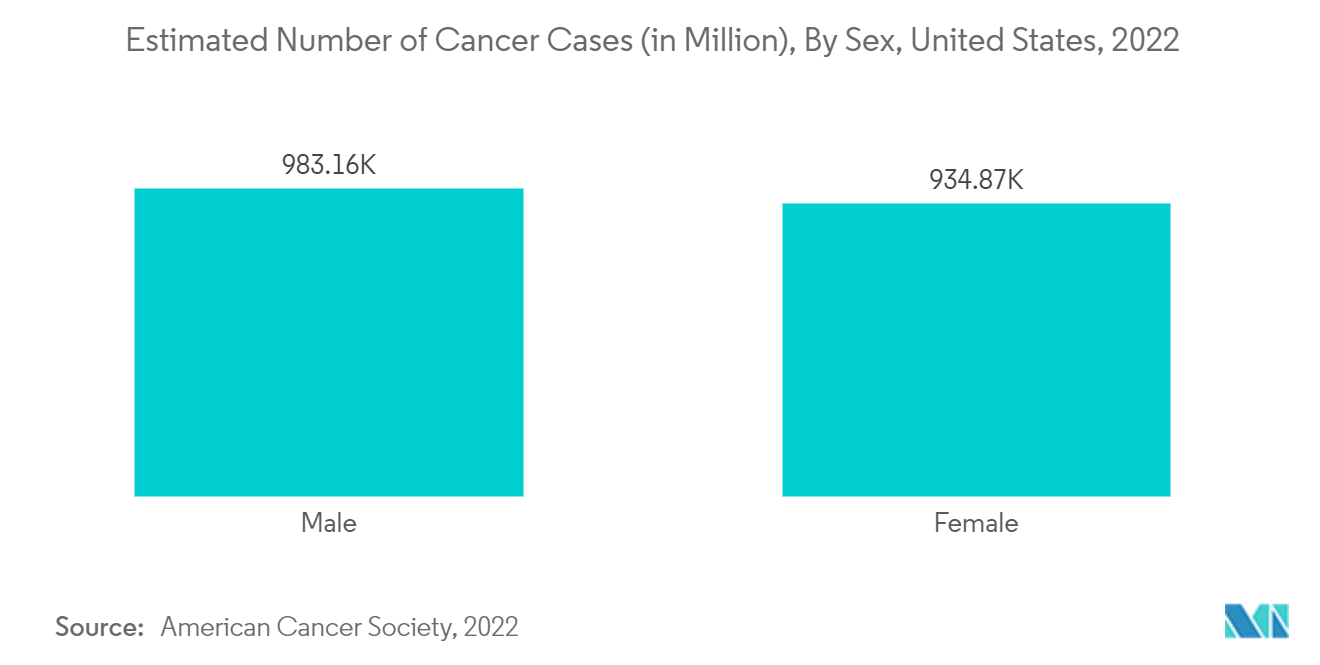
North America Expected to Hold a Significant Market Share
The use of artificial intelligence in the North American healthcare market is being driven by the increasing use of advanced technology in healthcare systems, the growth in funding of AI-based startups, the rising burden of chronic diseases in the country, the growing need to reduce healthcare costs, and the implementation of big data in healthcare.
The increased adoption of big data in healthcare in the region is expected to propel the market's growth. For instance, in August 2022, the Children's Hospital of Philadelphia (CHOP) and the University of Pennsylvania School of Medicine (Penn Medicine) launched the big data-driven Penn-CHOP Kidney Innovation Center, which will support research to improve patient care for adults and children with kidney disease. Moreover, the Association of American Medical Colleges reported in August 2022 that the United States spends USD 4 trillion per year on health care. Thus, the region is facing the need to minimize healthcare costs, which can be accomplished by applying AI in healthcare, thereby enhancing market growth.
Furthermore, introducing technologically advanced products into the market is expected to propel the market's growth. For instance, in December 2021, Crawford & Company introduced Crawford Intelligent Fraud Detection. It combined human expertise and forensic analysis, joining DXC Luxoft's Financial Crimes Intelligence platform with IBM, improvising how it recognizes and manages fraudulent claims for its clients. Additionally, in June 2022, My Intelligent Machines (MIMs) launched software with artificial intelligence that has the potential to transform the way organizations prepare for oncology clinical trials or drug development.
Strategic activities of the market players are also expected to support the market's expansion. For instance, in June 2022, Insilico Medicine opened a fully automated, artificial intelligence-driven robotics lab for drug research.
Thus, all the factors mentioned above, such as the growing demand for big data in healthcare and technologically advanced product launches, are expected to boost the market over the forecast period.
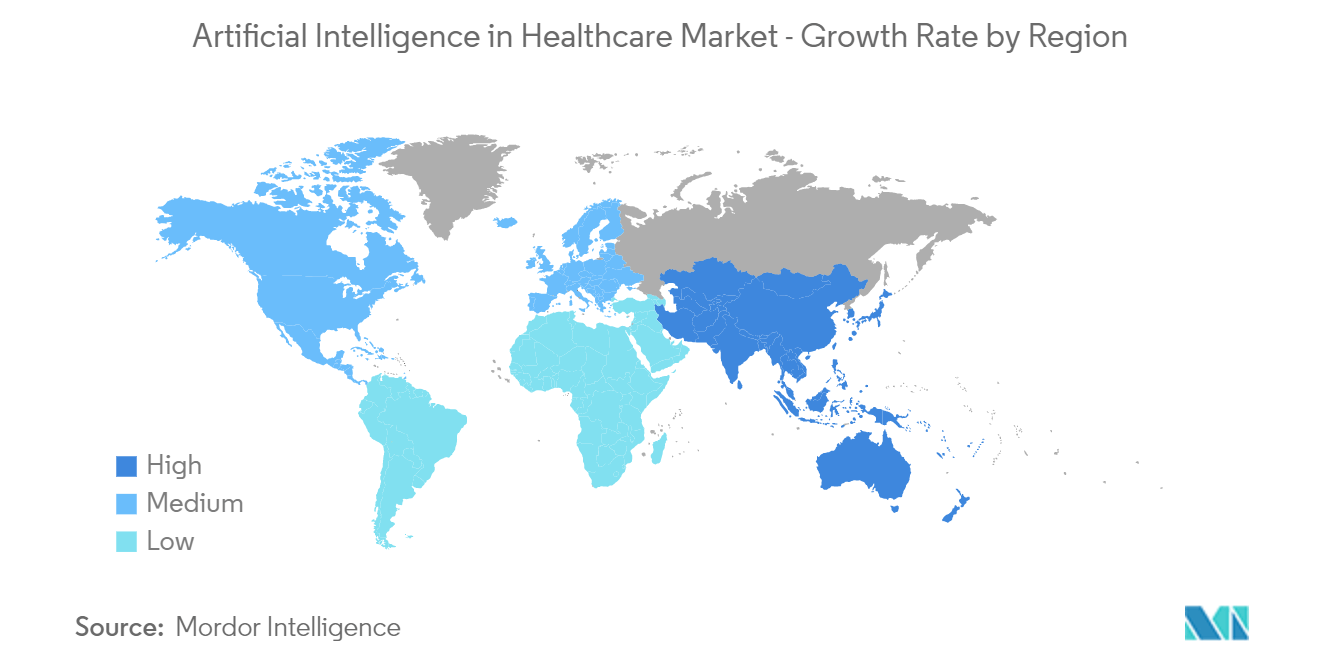
AI in Healthcare Industry Overview
Artificial intelligence in the healthcare market is highly competitive due to a significant number of players operating in the domestic and international markets. Due to the increase in the applications of AI across various healthcare, significant players in the market adopt strategies, such as product innovation and mergers & acquisitions. Some major players in the market include IBM Corporation, Google Inc., Microsoft Corporation, Intel Corporation, and Oracle Corporation, among others.
AI in Healthcare Market Leaders
-
IBM Corporation
-
Google Inc.
-
Microsoft Corporation
-
Intel Corporation
-
Oracle Corporation
- *Disclaimer: Major Players sorted in no particular order
AI in Healthcare Market News
- October 2022: Google Cloud unveiled new AI-powered imaging technologies to aid the accessibility and interoperability of radiology and other imaging data.
- October 2022: AtlantiCare integrated the Orbita virtual assistant and conversational AI platform. Individuals can use this technology to interact with their physicians more easily. The healthcare system can facilitate access to self-scheduling choices.
AI in Healthcare Industry Segmentation
Artificial intelligence in healthcare is an umbrella phrase for the use of machine-learning algorithms and software or artificial intelligence (AI) to simulate human cognition in the analysis, display, and comprehension of complicated medical and healthcare data. AI is the ability of computer algorithms to estimate conclusions based purely on input data.
The Artificial Intelligence in Healthcare Market is Segmented by Technology (Natural Language Processing (NLP), Deep Learning, Context Aware Processing, Querying Method, and Other Technology Types), Application (Robot-assisted Surgery, Virtual Nursing Assistants, Fraud Detection, Drug Discovery and Research, Dosage Error Reduction, Medical Imaging and Diagnostics, Wearables, and Other Application Types), Offering (Hardware, Software, and Services), End-user (Healthcare Payers, Healthcare Providers, Pharmaceutical and Biotechnology Companies, Patients, and Other End-user Types), and Geography (North America, Europe, Asia-Pacific, Middle-East and Africa, and South America). The market report also covers the estimated market sizes and trends for 17 different countries across major regions globally. The report offers the value in USD million for all the above segments.
| By Technology | Natural Language Processing (NLP) | ||
| Deep Learning | |||
| Context Aware Processing | |||
| Querying Method | |||
| Other Technology Types | |||
| By Application | Robot-assisted Surgery | ||
| Virtual Nursing Assistants | |||
| Fraud Detection | |||
| Drug Discovery and Research | |||
| Dosage Error Reduction | |||
| Medical Imaging and Diagnostics | |||
| Wearables | |||
| Other Application Types | |||
| By Offering | Hardware | ||
| Software | |||
| Services | |||
| By End-user | Healthcare Payers | ||
| Healthcare Providers | |||
| Pharmaceutical and Biotechnology Companies | |||
| Patients | |||
| Other End-user Types | |||
| By Geography | North America | United States | |
| Canada | |||
| Mexico | |||
| Europe | Germany | ||
| United Kingdom | |||
| France | |||
| Italy | |||
| Spain | |||
| Rest of Europe | |||
| Asia-Pacific | China | ||
| Japan | |||
| India | |||
| Australia | |||
| South Korea | |||
| Rest of Asia-Pacific | |||
| Middle East and Africa | GCC | ||
| South Africa | |||
| Rest of Middle East and Africa | |||
| South America | Brazil | ||
| Argentina | |||
| Rest of South America | |||
AI in Healthcare Market Research FAQs
What is the current Artificial Intelligence in Healthcare Market size?
The Artificial Intelligence in Healthcare Market is projected to register a CAGR of 42.2% during the forecast period (2025-2030)
Who are the key players in Artificial Intelligence in Healthcare Market?
IBM Corporation, Google Inc., Microsoft Corporation, Intel Corporation and Oracle Corporation are the major companies operating in the Artificial Intelligence in Healthcare Market.
Which is the fastest growing region in Artificial Intelligence in Healthcare Market?
Asia-Pacific is estimated to grow at the highest CAGR over the forecast period (2025-2030).
Which region has the biggest share in Artificial Intelligence in Healthcare Market?
In 2025, the North America accounts for the largest market share in Artificial Intelligence in Healthcare Market.
What years does this Artificial Intelligence in Healthcare Market cover?
The report covers the Artificial Intelligence in Healthcare Market historical market size for years: 2021, 2022, 2023 and 2024. The report also forecasts the Artificial Intelligence in Healthcare Market size for years: 2025, 2026, 2027, 2028, 2029 and 2030.
Our Best Selling Reports
Artificial Intelligence in Healthcare Industry Report
Statistics for the 2025 Artificial Intelligence in Healthcare market share, size and revenue growth rate, created by Mordor Intelligence™ Industry Reports. Artificial Intelligence in Healthcare analysis includes a market forecast outlook for 2025 to 2030 and historical overview. Get a sample of this industry analysis as a free report PDF download.

